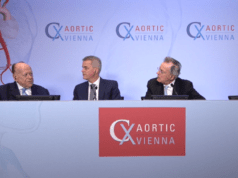
The third day of CX Aortic Vienna saw Italy’s vascular and endovascular expertise showcased on the global stage, in a live session hosted by the Italian Society of Vascular and Endovascular Surgery (Società Italiana di Chirurgia Vascolare ed Endovascolare; SICVE). Topics covered by some of Italy’s leading names in the aortic space included new technical solutions in custom-made aortic stent graft devices, elephant trunk surgery, and the use of a new branched device for the treatment of thoracoabdominal aortic aneurysms.
The session, which SICVE chose to stage in English to attract global participation, was moderated by Roberto Chiesa (Milan, Italy), who curated the programme, and Fabio Verzini (Turin, Italy), the latter standing in as a last minute replacement for SICVE president Stefano Camparini (Cagliari, Italy) who was absent for personal reasons.
Gianmarco Iannopollo (Milan, Italy) began discussions with his talk on supra-annular sizing of transcatheter aortic valve prostheses in raphe-type bicuspid aortic valve (BAV) disease.
Iannopollo presented findings from a prospective analysis of patients treated with a transcatheter aortic valve implantation (TAVI) for aortic stenosis in raphe-type BAV disease between November 2018 and January 2020, using different types of TAVI prostheses. Iannopollo and colleagues set out to evaluate the safety of a novel supra-annular sizing method to optimise prosthesis sizing in raphe-type BAV disease by performing sizing measurements at the LIRA (level of implantation at the raphe) plane—known as the LIRA method. “The application of the LIRA might optimise TAVI prosthesis sizing in patients with raphe-type BAV disease,” he suggested, “though further, larger studies are needed to confirm our preliminary findings.”
“Our technique is simple and easy. It avoids hypothermia and circulatory arrest, and provides a perfectly bloodless operative field”—said Marco Di Eusanio (Ancona, Italy), who despite technical challenges with his presentation, described to the audience a novel, hybrid frozen elephant trunk surgery developed at his institution. Di Eusanio commented that total arch replacement with frozen elephant trunk is “reproducible, safe, and effective”, and went on to say that hypothermia and circulatory arrest were the main limitations of this approach.
Domenico Angiletta (Bari, Italy) next presented his team’s preliminary results from a multicentre Italian registry on the use of a new branched device for the treatment of thoracoabdominal aortic aneurysms. The observational, retrospective cohort study aimed to describe early and late outcomes of endovascular repair of complex aortic lesions using the 24Fr Colt branched endograft (CryoLife).
“In our preliminary experience,” Angiletta remarked, “endovascular repair of thoracoabdominal aortic aneurysms and complex pararenal abdominal aortic lesions with the new Colt branched endograft is technically safe and effective. The survival rate was satisfactory in this high-risk cohort, and technical outcomes at early follow-up are encouraging, including the absence of threatening endoleaks and the high target visceral vessel patency.”
Pathology and condition of the aorta key to device selection
Stefano Gennai (Modena, Italy) was next to speak, highlighting the importance of selecting an aortic device according to pathology and the condition of the aorta. Distal aortic fixation allows a significant reduction of the distal endoleak rate without any related complications, Gennai told the CX Aortic Vienna audience. Presenting a comparison of distal active fixation versus a standard stent graft, Gennai concluded that their results, which were favourable towards distal active fixation, “should be considered relevant due to the threatened hostile anatomy.”
He continued: “We think that the thoracic distal landing zone issues were not studied in-depth, and therefore merit further investigations due to its primary importance.”

Mauro Gargiulo (Bologna, Italy) offered attendees an insight into a flexible and fast multi-staged endovascular repair of thoracoabdominal aneurysms by fenestrated and branched endografts. This approach can be proposed for endovascular treatment of thoracoabdominal aneurysms according with the endograft design and the patient’s clinical conditions. “The satisfactory rates of permanent paraplegia and perioperative mortality balance the prolonged hospitalisation and perioperative morbidities,” Gargiulo concluded.
Discussion leads to consensus on the benefits of a staged approach Gargiulo’s presentation prompted discussion between panellists over the merits of employing a staged approach to EVAR—with consensus that staging the procedure is favourable as it is associated with reduced spinal cord ischaemia.
Francesco Talarico (Palermo, Italy) closed the SICVE session with a presentation detailing the first experience in Europe of a new technical solution in custom-made aortic stent grafts.
“In complex anatomies, we usually use different, custom-made devices,” he said. “Recently, a new custom-made stent graft has appeared on the market”. Describing the Italian-designed, Brazilian-made Braile stent graft, Talarico enumerates the device’s technical features: 18–22Fr delivery system; aortic neck, 10mm; aortic diameter, up to 44mm; stent length, up to 300mm; up to 4GW pre-mounted for the branch; 360 degree circumferential fenestration, with the possibility of semi-circumferential fenestration (for example of 122 degree).
After presenting the successful first and second use of this stent in Europe, in a 74-year-old man and an 82-year-old woman, respectively, Talarico wanted to leave the CX Aortic Vienna audience with this take-away: “The various stent configurations and their interconnections, which allow the modulation of the radial force and ensure that anchoring and sealing are more effective and flexible, [and] make TEVAR easier.”
This session, and all other sessions from day three of CX Aortic Vienna, is available to view on demand. Click here to register and access the recording.













